The diversity of the global seafood industry means that very few generalisations can be made, especially as the sector consists of highly diversified industry clusters based on species or groups of species which share a similar market niche or technology platform.
We identify six subsectors representing the global seafood industry; shellfish, salmonids, whitefish, tuna, small pelagics and diversified processors and suppliers (see Figure 3). It could be argued that this is a relatively Western way of presenting the global seafood industry, one in which many of the Asian producers are underrepresented. Nevertheless, this categorisation does depict most of the largest producers and the main commercially significant species.
Shellfish is a diverse subsector incorporating a large number of species including crustaceans such as shrimps, crabs and lobsters, as well as molluscs such as mussels, oysters, scallops, abalones and even octopus and squid. In total, aquaculture and wild catch produce more than 31 million tonnes of shellfish globally.
The shellfish sector includes some of the highest value products on the animal protein spectrum. Shrimps, crabs, scallops and abalones, for instance, are significantly more expensive than most animal proteins, while lobsters and oysters represent the highest premium niche markets in the entire food industry. Shellfish producers range from small local producers to large, globally diversified corporations. Many of the latter are concentrated among the high-value and highly traded shrimp sector.
The world’s largest shrimp producer, based in Thailand, is Charoen Pokphand Foods (CPF). Key North American suppliers are Ocean Garden Products (OPG), Red Chamber Co., Eastern Fish and Clearwater, while in Europe, Royal Greenland, Heiploeg and Alfesca are among the largest suppliers. Spain-based Pescanova, although primarily a whitefish producer, is also a key supplier of shrimp from its aquaculture facilities in Central America.
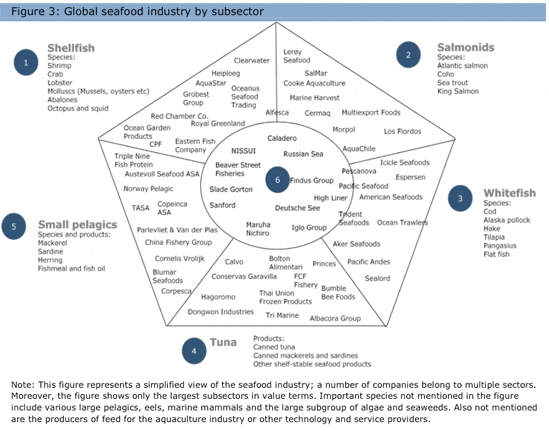
Aquaculture has developed strongly for many shellfish species and contributes over 60 per cent of the volumes produced in this subsector. The single most valuable shellfish segment is farmed marine shrimp, one of the world’s most advanced aquaculture sectors (see Figure 4).
Although marine shrimp wild catch amounts to over three million tonnes per year and the rapidly growing freshwater aquaculture of crustaceans produces more than 1.5 million tonnes annually, it is the marine shrimp aquaculture industry which deserves particular attention because of its rapid growth and economic significance. The farmed shrimp industry has developed rapidly from its humble beginnings in the 1980s. Relying initially on wild broodstock and a number of different species, the industry shifted towards farming the Penaeus monodon (black tiger shrimp) in the 1990s due to the development of breeding technology. The key drivers during that period were breeding technology and hatchery-produced juveniles, but the species’ poor resistance to disease impeded further growth of the sector. At the start of the twenty-first century, the introduction of the Latin American species P. vannamei (or whiteleg shrimp) to many Asian farming regions, especially in China and Thailand, gave the industry an unprecedented boost.
Although smaller in size than the P. monodon, the P. vannamei is more resistant to disease and can be farmed at higher densities. Its production cycle is also shorter than the P. monodon’s which allows two or even three yields per year, and it requires less protein in its diet. These advantages have created both a lower cost product and much higher profitability per hectare for the marine shrimp farmers.
In the last two years, the rapid growth of the industry has slowed. Disease and weather-related problems in key producer regions such as China, Thailand, Indonesia, Vietnam and others have lead to supply reductions or stagnation, causing prices to rise by 25 per cent to 30 per cent. It is likely that the only factor preventing further price rises is the negative macro-economic environment in key markets such as the EU, the US and Japan. Nevertheless, the expectation is that the higher shrimp prices in combination with continued technological developments will still ensure continued growth in the industry. In India in particular, the industry has the potential to make a strong contribution to supply growth in the next few years, since it only recently adopted the P. vannamei shrimp and the P. monodon is still its main species.
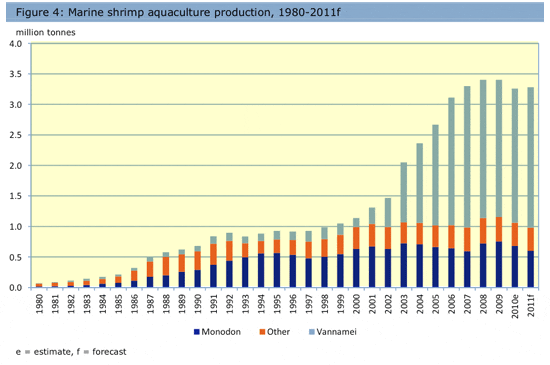
In the salmonids subsector there are three key farmed species, Atlantic salmon, salmon trout (also called steelhead) and coho, amounting to a combined annual production in excess of 1.6 million tonnes. There are also three important wild-caught species—pink, chum and sockeye—with a global production of approximately one million tonnes. Few of the salmonid species can be substituted for each other; pink is mostly used for canning while Atlantic salmon is the species used for fillets or smoked products. Sea trout and coho (known as red-fleshed salmons due to the distinct colour of their meat) are primarily consumed in Japan.
The most significant species in terms of volume in this industry is Atlantic salmon, which is exclusively produced by aquaculture. As mentioned previously, aquaculture of Atlantic salmon is concentrated in four producing countries: Norway, Chile, Canada and the UK (see Figure 5).
With the exception of canned pink salmon products, most salmon is still a premium protein, even in the US and the EU. In all key markets though, the mainstream Atlantic salmon products (such as fresh fillets) are approximately two or three times the price of poultry breast meat at both wholesale and retail levels. Although global salmonid production— including wild catch and the freshwater aquaculture of small (or brown) trout—amounts to less than four million tonnes globally, it is a significant subsector in value terms.
The global trade of salmonids is valued at approximately USD 12 billion per year. Most is transported fresh. The EU and the US are the traditional importers of Atlantic salmon and account for 70 per cent of global consumption, while Japan is the dominant market for the two other farmed species, sea trout and coho. Although these traditional markets still have potential for growth, it is the developing countries such as Russia, China, Brazil and others that are gradually becoming the growth engines of demand, especially for Atlantic salmon. Based on historical price and supply dynamics it is estimated that long-term global demand for Atlantic salmon is growing at approximately 6 per cent per year.
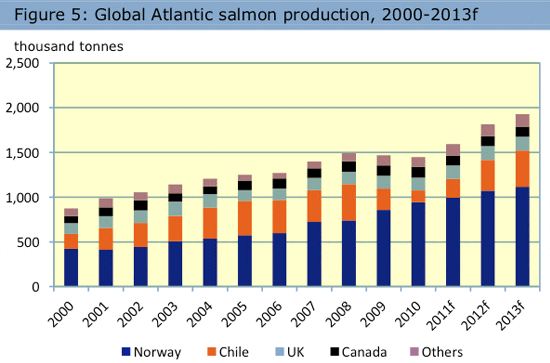
The salmon industry is considered the most mature and also the most technologically advanced and professionalised aquaculture industry. The salmon industry does not have artisanal back-yard producers, unlike almost all other aquaculture or animal protein sectors. The sector is relatively consolidated, with the largest 15 producers accounting for close to 65 per cent of global salmonid production, nearly all of which are publically listed companies. With over 20 per cent of global production, the clear global market leader is Marine Harvest, based in Norway. Cermaq, Leroy and Salmar are other large producers based in Norway; AquaChile is the largest producer based in Chile and Cooke Aquaculture is the largest Canadian producer.
Current dynamics in the salmon market are heavily influenced by supply developments in Chile, the second-largest producer after Norway. In 2008 and 2009 the Chilean industry was impacted by the outbreak of Infectious Salmon Anaemia (ISA) virus. The consequent contraction of Chilean production created a global salmon supply shortage and high prices during most of 2009 and 2010. By 2011, the Chilean industry had successfully restructured by focusing on improving bio-security. The initial harvests in the new industry model are recording the best biological performance (e.g. low mortality, high harvest weight) in the history of Chilean salmon production. As a result, the strong recovery of the Chilean industry is significantly increasing global salmon supply, causing a dramatic fall in salmon prices (see Figure 6). Rabobank expects that a generally low-price environment will persist, possibly until the end of 2013 or 2014, at which point global supply growth should slow down.
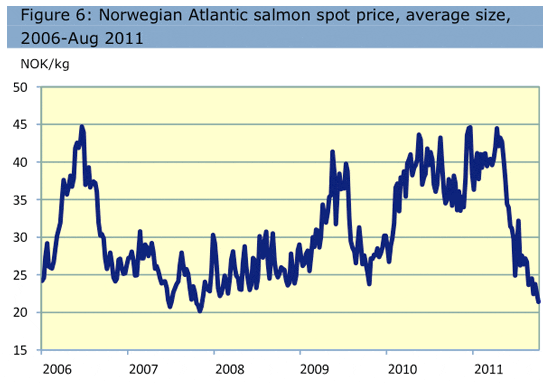
Whitefish represents the single largest and most diverse subsector of the global seafood industry. We identify five main subgroups based on the species and production system (see Figure 7).
Aquaculture is the key source of whitefish, with carp as the highest volume species. Dating back to the Middle Ages, carp aquaculture is one of the oldest aquaculture industries and is the largest in volume terms today. Carp is produced in all parts of the world, with the largest volumes coming from Asia and particularly China. There are different ways of producing carp; it can be produced extensively or with varying degrees of supplemental feeding. It is also produced in combination with livestock farming, where livestock waste is used to fertilise the carp pond, or in rice-paddy farming, where it is either farmed extensively in the rice paddy or in-between rice crops. As a low-value product, carp are produced either artisanally or as a by-product of a polyculture system and is consumed locally.
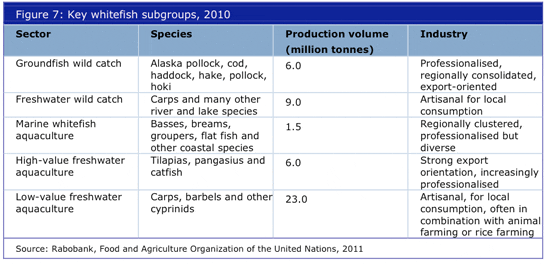
In contrast to carp farming, the higher value freshwater-aquaculture species, tilapia and pangasius, are produced by an increasingly professionalised industry with growing scale, significant value-added processing and strong export orientation. Tilapia is produced in many tropical regions around the world. The highest volumes originate in Asia, with China responsible for 45 per cent of global production. Pangasius production is concentrated in Vietnam, which accounts for more than 90 per cent of the global production volume of this species.
During the last decade, imports of tilapia and pangasius to the US and EU markets have achieved double-digit annual growth Although the US and the EU are the largest importers and are still growing rapidly, tilapia and pangasius are becoming common in markets such as China, Russia, Brazil, Mexico, Egypt and others. As omnivorous species, tilapia and pangasius can utilise low-cost feed. Moreover, they can be processed into fillets by a skilled, low-cost labour force in the vicinity of the aquaculture operations. Consequently, as the lowest cost seafood option in Western markets, these two species have gained market share.
Interestingly, regions which traditionally are not large per capita seafood consumers are among the key importers of these species, for instance Germany and Poland. Tilapia and pangasius production volumes combined grew 330 per cent between 2000 and 2009 and represent one of the fastest growing protein-producing industries worldwide.
Despite the presence of a large whitefish aquaculture industry, it is the groundfish wild- catch sector that is still the most valuable and economically significant whitefish industry. Groundfish, as the name suggests, are species found close to the bottom of the water column. The key species are Alaska pollock harvested by Russian and US fleets in the Bering Sea and Atlantic cod mostly produced by Norwegian and Russian fleets in the Barents Sea. When other species such as haddock, hake and hoki are included, groundfish production in 2010 was close to six million tonnes (see Figure 8)
It should be noted that during the 1980s, the harvest of groundfish was above 10 million tonnes and even surpassed 11 million tonnes in 1987. These harvest volumes exceeded what are now considered sustainable limits and resulted in overfishing. In the following two decades, increased attention was paid to limiting the harvest and improving sustainability. Currently, the wild biomass of Alaska pollock, Atlantic cod, haddock and other groundfish is very healthy and is estimated to be the best in more than two decades. Given the health of the wild population, TAC quotas have been gradually increasing over the last three years. The expectation is that production volumes will stabilise at the volumes achieved in 2011 or 2012. Although it will probably be possible to increase the TAC more on the basis of the wild biomass, growth is likely to be limited for precautionary purposes. With this in mind, the groundfish sector is expected to be one of the more stable sectors in the seafood industry.
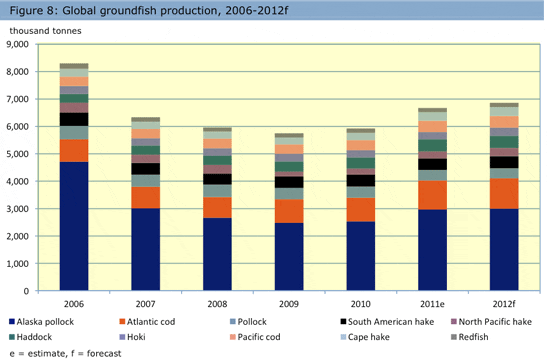
Due to the conservation efforts of the last two decades, the global groundfish industry is supplied by some of the best managed fisheries in the world. It is also the sector with the most MSC-certified fisheries, the largest of which are the US Alaska pollock fishery and the European Atlantic cod fishery in the Barents Sea. In the last few years, one consequence of the regulation of this sector has been the relatively stable supply and lower price volatility than that seen in other seafood sectors.
This industry is considered the most mature wild-catch sector. Producers are relatively large, professionalised and well-capitalised and can therefore invest significant funds in vessels, plants and product development. Some of the main value-added products (VAP) products in the seafood sector are based on groundfish. These include frozen and fresh fillets and a wide variety of fish preparations such as ready-to-cook meals, fish fingers and other breaded and battered VAP products. Groundfish is also the basis for surimi, a key ingredient in imitation crab salads, among other products. While it can be processed on factory vessels, a significant proportion of groundfish processing occurs in China: one of the largest whitefish harvesters and processors is Hong Kong-based Pacific Andes. In Europe, Pescanova, owner of one of the world’s largest fishing fleets, is a key supplier of groundfish to the Spanish market. Aker Seafoods is the leading Norwegian harvester and processor. American Seafoods, Trident and Pacific Seafoods are among the leading whitefish suppliers based in North America.
The tuna industry relies exclusively on wild-caught production and has no commercially significant aquaculture production. There are four main species: skipjack, yellowfin, bigeye and albacore (see Figure 9). The vast majority of the harvested volume is used in the canning industry, particularly skipjack, which is almost exclusively canned. By contrast, the fifth most notable species, bluefin (Southern, Atlantic and Pacific bluefin tuna, represent one per cent of production), is not used for canning but provides the raw materials for the premium end of the sashimi market. Developments are underway which could lead to aquaculture of bluefin tuna on a commercial scale within the next five to 10 years.
With the exception of the bluefin, all tuna are harvested in tropical and warm ocean waters with the Pacific Ocean accounting for close to 70 per cent of global supply. In the last five years, the global harvest of the main tuna species has fluctuated between 4.2 million and 4.5 million tonnes. With the exception of skipjack production, volumes have been relatively stable since the 1990s. Skipjack production has doubled since 1990 from below 1.3 million tonnes to close to 2.6 million. Despite the high production volume, the skipjack tuna is probably the only species which is exploited below the maximum possible level. Skipjack are the smallest of the tuna species, short-lived, highly fecund and have a healthy global biomass.
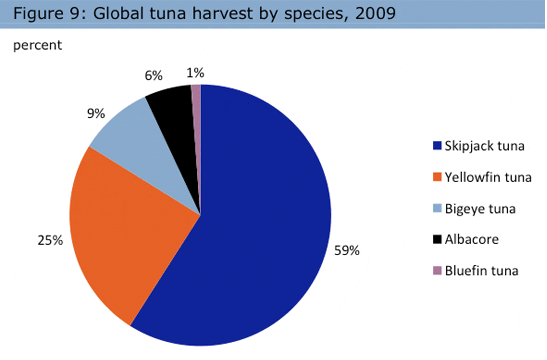
Canned tuna is a global product, consumed in many countries. The EU, Japan and the US are by far the largest markets. In Europe, Spain, Italy, the UK and France are the largest per capita consumers of canned tuna and as a group represent more than a quarter of global canned tuna consumption. These are also the most developed markets, with the largest variety of products and the fastest product innovation. These markets have led the way for a gradual global transformation of the basic, relatively simple and low-cost product: in the last ten years, new and specialised value-added applications have been developed for canned tuna, such as sandwiches, pastas, salads and on-the-go snacks. The product diversification has allowed canned-tuna producers not only to acquire new consumers but also to increase the average unit price. Product innovation has been the key tool to combating the strong raw material price increases (see Figure 10).

The canned-tuna companies represent a unique subsector of the seafood industry. Firstly, canned tuna is highly branded with a larger market penetration of brands than any other seafood subsector. Secondly, by diversifying into other species which can be canned or preserved, tuna canners have created the shelf-stable seafood category. The global shelf-stable seafood market is estimated at EUR 17 billion, with western Europe representing more than one-third of this market. Canned products offer the convenience of not requiring any refrigeration and have a shelf life of up to a few years, which has been a demand driver for the sector. Another important feature of the shelf-stable seafood category is that it is the category least impacted by macroeconomic cycles.
Even though tuna is the main species of the shelf-stable seafood category, many other species are also canned or jarred; pink salmon, sardines, mackerel, herring and others provide further species diversification to the canned-tuna companies. Thailand has the world’s largest tuna canning industry and is home to the world’s largest tuna canning company, Thai Union Frozen Products. Other large Asian producers are Dongwon Industries from South Korea and Hagoromo Foods Corporation from Japan. In Europe, Bolton Alimentari is the largest tuna canner, while in North America Bumble Bee Foods is the leader in the broader shelf-stable seafood category. Tri Marine based in the US, FCF Fishery from Taiwan and Albacora from Spain are leading suppliers of raw material for tuna canning (whole fish or loins).
The tuna industry has been consolidating and this trend is expected to continue. Margin pressure due to rising raw material prices is a key driver for consolidation. Moreover, in European markets in particular, the increasing penetration of private-label products has put pressure on the branded producers. Lacking scale and facing potential market share loss, the smaller tuna canners are either moving to defendable niche markets or are being acquired by the branded market leaders.
Small pelagics are small, schooling fish. They inhabit open ocean waters and are found near the surface or throughout the water column. Most of the small pelagic species are at the bottom of the food chain, preyed on by large pelagics such as tuna, and by seabirds and sea mammals. Peruvian anchovy is the largest-volume pelagic fishery, but there are many other species, such as various mackerels, Atlantic herring, blue whiting, menhaden and various sardine types. Peru, Chile and the Nordic countries are the key producers. Like tuna, the small pelagic sector relies entirely on wild catch with no aquaculture production. Of the global catch of close to 30 million tonnes, 75 per cent to 85 per cent is used to produce fishmeal and fish oil, with the rest going to human consumption. After processing, the total small pelagic catch yields approximately 5.5 million and 1.2 million tonnes of fishmeal and fish oil, respectively, a figure which has stayed relatively constant in the last decade.
Fishmeal and fish oil are ingredients used in the feed for aquaculture species and for terrestrial farmed animals. Approximately equal parts of the available fishmeal supply are consumed by four industries: pig farming, salmon aquaculture, shrimp aquaculture and other farmed seafood species. In the case of fish oil, the salmon aquaculture industry consumes close to 80 per cent of the available supply with the remainder going to the fast- growing human consumption market, either as a food ingredient or as the raw material for Omega 3 capsules. Although weather events such as El Niño and La Niña have caused significant temporary fluctuations, the global small pelagic catch has not changed materially in the last two decades. In contrast, demand has continually increased for use as feed for the expanding aquaculture industry and for the human consumption market. The inevitable result has been rising prices (see Figure 11).

The combination of rising demand and higher prices of fishmeal and fish oil has triggered feed manufacturers to replace these ingredients in feed formulations with vegetable meals and vegetable oils. Consequently, the price of substitutes such as soymeal and rapeseed oil are an important influence on the price of fishmeal and fish oil, respectively. As prices rose in the last decade, inclusions of fishmeal and fish oil in feed declined. However, because aquatic feed must display certain functionality and performance characteristics, it is difficult to continue reducing this inclusion rate in many feed formulations, particularly for the carnivorous aquacultured species such as salmon.
Moreover, another strong demand driver in this subsector is the growing human consumption markets, either for small pelagic fish directly, for instance in African markets, or for the fish oil for omega 3 capsules in Western markets. Despite their rising prices, small pelagic species are still relatively inexpensive in comparison to all other seafood and other proteins. They are among the lowest priced seafood species, with prices ranging from a few hundred US dollars per tonne up to USD 2,000 per tonne for certain small pelagics for human consumption. Given the positive demand and fixed supply, the expectation is that prices may continue to rise for the foreseeable future.
Like other wild-catch sectors, the small pelagics sector has experienced increasing regulation, the establishment of TAC quotas or effort-based methods to limit catch volumes. Establishing catch quotas or other catch-control methods creates the conditions for consolidation. The small pelagics sector has experienced many mergers and acquisitions (M&A) in the last decade resulting in the formation of large industrial fleets, some with a global presence. The pelagic fleets use ‘super trawlers’, the largest and most sophisticated fishing vessels in the seafood industry. Only companies above a certain size can efficiently utilise these vessels, providing strong synergies from consolidation.
Consolidation, synergies, efficient utilisation of large vessels, rising end-product prices and limitations on supply growth are the features which have ensured that the leading vertically integrated producers in this sector are among the most profitable companies in the seafood sector—and even in the entire animal protein industry. Peru and Chile have the largest pelagic fisheries and account for approximately 40 per cent of global fishmeal and fish oil production. Tecnólogica de Alimentos SA (TASA) and Copeinca ASA are the leading producers based in Peru, with Blumar Seafoods and Corpesca the key producers from Chile.
Based in Norway, Austevoll Seafood Group ASA is one of the world’s largest harvesters of small pelagics, while Parlevliet & Van der Plas and Cornelis Vrolijk from the Netherlands are the key producers of human consumption pelagics. Finally, China Fishery Group, part of Pacific Andes, is the leading Asia-based pelagics harvester. The high barriers to entry in this industry and continuing strong demand suggest that producers in this sector will generate strong profitability for the foreseeable future. Rabobank expects this sector to consolidate further so that only a few large producers will control the global supply of small pelagics within a decade.
The final subsector in this framework of the seafood industry consists of highly diversified seafood processors with many species in the product portfolio (see middle section of Figure 3). A key feature of the diversified processors is that each one is typically a regional leader of a broad seafood category such as fresh packaged seafood or frozen seafood. For instance, Deutsche See is the key supplier in Germany with a particularly strong position in the food service sector; Caladero Seafood is the largest producer of fresh packaged seafood in Spain, and Russian Sea Group is the leading supplier of seafood in Russia.
A close relationship with the retailers allows the diversified producers to be category leaders for the retailers and, consequently, the key drivers of innovation, product development and promotion in the seafood sector. Some also own the most recognised brands in the industry, such as Iglo Group, High Liner Foods and Findus Group. However, being a one- stop shop or category leader for the retailer is not the only advantage of having a multi- species portfolio. Diversification mitigates the impact of single commodity price fluctuation, such as salmon or shrimp spot prices. Salmon farmers are subject to substantial spot-price volatility and consequently, a few years of high profitability may be followed by a few years of low profitability or losses.
In contrast, the performance of a supplier which has exposure to the full spectrum of global seafood will be more stable. The fact that they are diversified over many species means that few of the producers are vertically integrated: investment in any one industry’s upstream subsectors will only ensure vertical integration for a small part of the product portfolio.
Consolidation, partly induced by retailers seeking to rationalise their supplier base, is a key dynamic among the diversified seafood processors. Single-species processors find themselves in a difficult position between the consolidated and large retailers and a volatile seafood commodity. This focused strategy is only possible if the processor is a key regional leader that either has sufficient geographical and client diversification or is vertically integrated. Finally, financial investors, particularly private equity (PE) investors, have acted as a catalyst to consolidation in this sector by acquiring smaller processors and creating diversified regional leaders.
Further Reading
| |
- | Go to our previous news item on this story by clicking here. |


